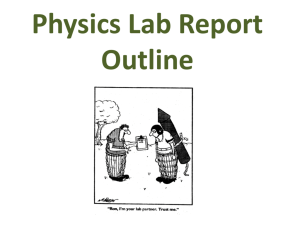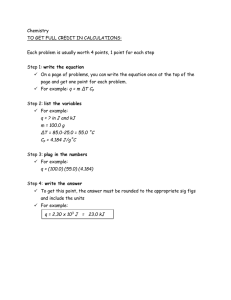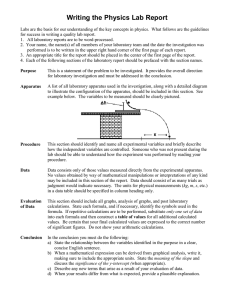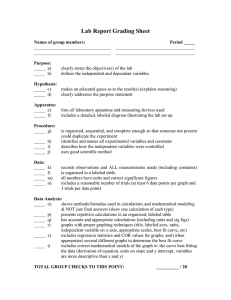AP Physics AB Lab Report Format
advertisement
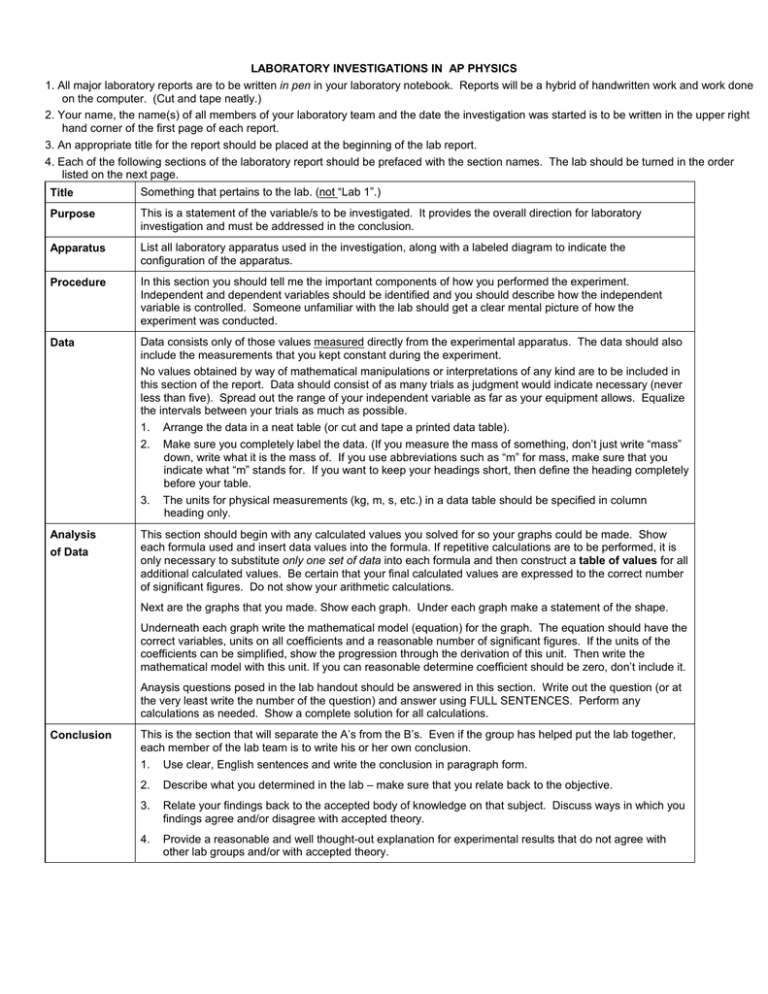
LABORATORY INVESTIGATIONS IN AP PHYSICS 1. All major laboratory reports are to be written in pen in your laboratory notebook. Reports will be a hybrid of handwritten work and work done on the computer. (Cut and tape neatly.) 2. Your name, the name(s) of all members of your laboratory team and the date the investigation was started is to be written in the upper right hand corner of the first page of each report. 3. An appropriate title for the report should be placed at the beginning of the lab report. 4. Each of the following sections of the laboratory report should be prefaced with the section names. The lab should be turned in the order listed on the next page. Title Something that pertains to the lab. (not “Lab 1”.) Purpose This is a statement of the variable/s to be investigated. It provides the overall direction for laboratory investigation and must be addressed in the conclusion. Apparatus List all laboratory apparatus used in the investigation, along with a labeled diagram to indicate the configuration of the apparatus. Procedure In this section you should tell me the important components of how you performed the experiment. Independent and dependent variables should be identified and you should describe how the independent variable is controlled. Someone unfamiliar with the lab should get a clear mental picture of how the experiment was conducted. Data Data consists only of those values measured directly from the experimental apparatus. The data should also include the measurements that you kept constant during the experiment. No values obtained by way of mathematical manipulations or interpretations of any kind are to be included in this section of the report. Data should consist of as many trials as judgment would indicate necessary (never less than five). Spread out the range of your independent variable as far as your equipment allows. Equalize the intervals between your trials as much as possible. 1. Arrange the data in a neat table (or cut and tape a printed data table). 2. Make sure you completely label the data. (If you measure the mass of something, don’t just write “mass” down, write what it is the mass of. If you use abbreviations such as “m” for mass, make sure that you indicate what “m” stands for. If you want to keep your headings short, then define the heading completely before your table. 3. The units for physical measurements (kg, m, s, etc.) in a data table should be specified in column heading only. Analysis This section should begin with any calculated values you solved for so your graphs could be made. Show each formula used and insert data values into the formula. If repetitive calculations are to be performed, it is only necessary to substitute only one set of data into each formula and then construct a table of values for all additional calculated values. Be certain that your final calculated values are expressed to the correct number of significant figures. Do not show your arithmetic calculations. of Data Next are the graphs that you made. Show each graph. Under each graph make a statement of the shape. Underneath each graph write the mathematical model (equation) for the graph. The equation should have the correct variables, units on all coefficients and a reasonable number of significant figures. If the units of the coefficients can be simplified, show the progression through the derivation of this unit. Then write the mathematical model with this unit. If you can reasonable determine coefficient should be zero, don’t include it. Anaysis questions posed in the lab handout should be answered in this section. Write out the question (or at the very least write the number of the question) and answer using FULL SENTENCES. Perform any calculations as needed. Show a complete solution for all calculations. Conclusion This is the section that will separate the A’s from the B’s. Even if the group has helped put the lab together, each member of the lab team is to write his or her own conclusion. 1. Use clear, English sentences and write the conclusion in paragraph form. 2. Describe what you determined in the lab – make sure that you relate back to the objective. 3. Relate your findings back to the accepted body of knowledge on that subject. Discuss ways in which you findings agree and/or disagree with accepted theory. 4. Provide a reasonable and well thought-out explanation for experimental results that do not agree with other lab groups and/or with accepted theory. Physics Laboratory Write-up Checklist 1. Group names, written on one side only, lab in correct order _____ 2. Each section clearly labeled, neat and organized _____ 3. Spelling correct _____ 4. Punctuation, complete sentences, correct grammar _____ 5. In ink or word processed, no fringe _____ 1. Pertains to the lab _____ Purpose 1. Relationship/s to be studied is/are clearly stated Apparatus & Procedure 1. List of equipment, diagram drawn with all components labeled _____ 2. Clear sequence of steps _____ 3. Control of variables is provided, dependent/independent variables identified _____ 1. Measurements organized into a neat table _____ 2. Values kept constant are on data page _____ 3. Values are clearly labeled _____ 4. Units on all values, sig figs reasonable _____ 5. Multiple trials with repetitions _____ 6. Range of data appropriate _____ 7. Data of good quality _____ 8. No calculated values in raw data _____ 1. 2. Neat tables of calculated values (sig figs, units) Sample calculations (put right before or after table) _____ _____ 3. Graphs a. title b. variables on appropriate axes, units included c. scale appropriate d. line appropriate Format of Lab Title Data Evaluation of Data Interpretation of graphs (put these under the graphs) a. statement on shape of graph/s b. mathematical model (equation variables correct, units on coefficients, sig figs reasonable, units reduced if possible) 5. Anaysis Questions a. Answered completely using full sentences. b. Complete solutions for calculations _____ _____ _____ _____ _____ _____ _____ _____ _____ Conclusion _____ 1. Written in paragraph form using complete sentences. 2. Clearly describes what was learned in the lab a. Relates back to the objective 3. Findings are related to a generally accepted body of knowledge a. Accepted theory is interpreted correctly _____ _____ 4. Indentification of error and reasonable explanation _____ _____ _____
